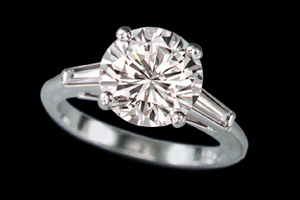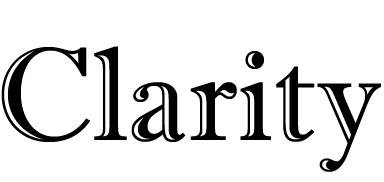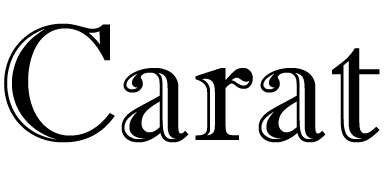Diamonds that are cut too deep will leak light from the bottom facets and not produce the Fire and Scintilliation that many love about a quality cut diamond.
Diamonds that are cut too shallow, may appear larger, however will leak light from the bottom facets and not produce the Fire and Scintilliation that many love about a quality cut diamond.
A well cut diamond enables light to enter through the top pavillion and reflect off the diagonal facets of the stone and will return that light back through the pavillion – producing the Fire and Scintilliation diamonds are famous for.

Qualities of Diamond Cut
Qualities of Cut
At the simplest level, cut is the way the diamond has be cut into a shape, for example, round brilliant cut, marquise cut, princess cut, etc… the shape the rough diamond has been fashioned by cutting. However, the deeper meaning of cut has to do with the proportioning of the diamond when it is being cut. There is a standard for cutting round diamonds, and it is judged against a mathematical ideal. There are few diamonds that are absolutely perfectly ideal proportions, but most are cut within an acceptable range of “ideal”. Diamonds that are cut outside too far out of the ideal range have diminished brilliance, fire, and scintillation.
If two diamonds are the exact same carat weight, clarity, and color, but look very different; one having less brilliance, fire, and scintillation, the fault lies in the cutting. A careful examination will show the diamond’s facet angles and proportions do not come up to the standards of a perfectly “ideal” cut diamond. The cutter may have chosen to sacrifice some brilliance to gain a greater carat weight.
Since fancy cut diamonds (marquise, pear, princess, oval, emerald cuts, etc…) are invariably designed to take advantage of odd shaped diamond rough, they usually yield about the same finished weight to rough as a round brilliant cut diamond, and hence are priced comparably. However, pricing of fancies does depend on quality of the diamond. It’s not possible to set precise pricing guidelines because each diamond has to be judged individually. Like people, no two diamonds are exactly alike!
GIA started the color grading scale with the letter D in the alphabet so as not to confuse with the color grading scale of A, B and C that was already being used. While the top color grade is D, all other diamonds are graded below this in the alphabet; E, F, G… and so on.
Completely colorless diamonds are extremely rare; only a very small percentage of gem quality diamonds fall into this category. Top graded colorless diamonds command prices well above the next best colors.
While the top color grade is D, all other diamonds are graded below this in the alphabet; E, F, G… and so on. While the relative difference between a “D” and an “E” diamond may be discernible only to the most expert trained eye, that slight grading difference can translate into a much higher price for the “D” graded diamond.

Qualities of Diamond Color
Qualities of Color
Most diamonds that are used in jewelry appear colorless or clear to the eye, yet with few exceptions, all diamonds have a hint of body color. Completely colorless diamonds are extremely rare; only a very small percentage of gem quality diamonds fall into this category. Top graded colorless diamonds command prices well above the next best colors. In the accepted grading scale used by the Gemological Institute of America (GIA), a colorless diamond is given the grading of “D”. Before a universal color grading scale was determined, many jewelry stores had used the letters, A, B, and C, to grade the diamonds in their inventory. GIA started the color grading scale with the letter D in the alphabet so as not to confuse with the color grading scale of A, B and C that was already being used. While the top color grade is D, all other diamonds are graded below this in the alphabet; E, F, G… and so on. While the relative difference between a “D” and an “E” diamond may be discernible only to the most expert eye, that slight grading difference can translate into a much higher price for the “D” graded diamond.
Diamonds with a tinge of body color are considered less desirable, however, a diamond with intense color, such as a pink, blue, or canary colored diamond are considered to be very valuable. Such diamonds are rare, particularly the blues and pinks, and even rarer, green colored diamonds. Diamonds do occur in virtually all colors of the spectrum and these colored diamonds are called “fancies”. The deeper colors have great beauty, however they usually do not have the brilliance of the lighter colors.
Truly perfect clarity is extremely rare in diamonds; such top-graded diamonds are graded, “flawless (FL)” By Federal Trade Commission standards, a flawless diamond is one in which no inclusions are visible to the trained eye under 10-power magnification in good light.
Inclusions affect the price of the diamond because they can interfere with the passage of light through the diamond and hence diminish its brilliance.
A diamond does not have to be flawless to be beautiful. If inclusions do not distract from the beauty of the diamond, they can be considered an internal blueprint of the diamond and what makes each diamond identifiable and unique.

Qualities of Diamond Clarity
Qualities of Clarity
When a diamond is being formed underground under high pressure and temperatures, nature usually includes something in the rough diamond. These are called “inclusions”, and they can be viewed under 10-power magnification in good light. They are called inclusions because they are within the diamond – tiny bubbles, specks of uncrystallized carbon, and sometimes traces of other minerals present when the diamond was formed.
Truly perfect clarity is extremely rare in diamonds; such top-graded diamonds are graded, “flawless (FL)” By Federal Trade Commission standards, a flawless diamond is one in which no inclusions are visible to the trained eye under 10-power magnification in good light.
Inclusions affect the price of the diamond because they can interfere with the passage of light through the diamond and hence diminish its brilliance. The degree to which this occurs is indicated by GIA’s clarity grading scale:
FL = Flawless
IF = Internally Flawless
VVS1 = Very Very Slight Inclusions (1)
VVS2 = Very Very Slight Inclusions (2)
VS1 = Very Slight Inclusions (1)
VS2 = Very Slight Inclusions (2)
SI1 = Slightly Included (1)
SI2 = Slightly Included (2)
I1 = Included (1)
I2 = Included (2)
I3 = Included (3)
The European Gemological Laboratory (EGL) has a clarity grading of SI3 which is the equivalent of GIA’s I1 clarity grade.
A diamond does not have to be flawless to be beautiful. If inclusions do not distract from the beauty of the diamond, they can be considered an internal blueprint of the diamond and what makes each diamond identifiable and unique.
The carat, which is the expression of weight of a gemstone, derives from the carob seed, an extremely uniform seed found in nature. The carat is today defined according to the metric system as 200 milligrams, or one-fifth of a gram.
Because the rarity of diamonds increases with size, so does their price per carat. That being true, a two-carat diamond costs more than twice as much as a one-carat diamond of the same quality because the two-carat size is much more rare than the one-carat size.
A diamond is priced “per carat”, taking into consideration both size and quality of the stone. Where two diamonds weigh exactly the same, the one of better color and clarity will command a higher price per carat.

Qualities of Diamond Carat Weight
Qualities of Carat
The carat, which is the expression of weight of a gemstone, derives from the carob seed, an extremely uniform seed found in nature. The carat is today defined according to the metric system as 200 milligrams, or one-fifth of a gram. Probably one of the easiest ways to explain carat weight of a diamond to a customer is to compare it to pennies in a dollar. There are 100 pennies in one dollar. So, if you have 50 pennies, you have ½ of a dollar… and 75 pennies would equal ¾ of a dollar. Similarly, 100 points equals 1 carat. If you have a 50 point diamond, you have a ½ carat. A 75 point diamond equals a ¾ carat diamond… and again, 100 points equals 1 carat.
A diamond is priced “per carat”, taking into consideration both size and quality of the stone. Where two diamonds weigh exactly the same, the one of better color and clarity will command a higher price per carat. Because the rarity of diamonds increases with size, so does their price per carat. That being true, a two-carat diamond costs more than twice as much as a one-carat diamond of the same quality because the two-carat size is much more rare than the one-carat size.
THE FOUR C’S SUMMARY:
The Four C’s are the building blocks when choosing your new diamond. At Diamonds Direct, you will learn about the Four C’s and you will be able to make an educated and informed decision about what diamond is right for you. Your diamond purchase will come with a certificate and paperwork defining the cut, color, clarity, and carat weight of the diamond. You will feel confident that you made the best diamond choice for your money!

Jewelry That Stands The Test of Time
Fine jewelry isn’t just for newly weds. Celebrate your love and anniversary with a beautiful piece to pass along through the generations.

How Do You Celebrate That Special Someone?

Choose with Confidence
Imagine the confidence you’ll feel when shopping for the perfect diamond with a trusted, knowledgeable advisor.






